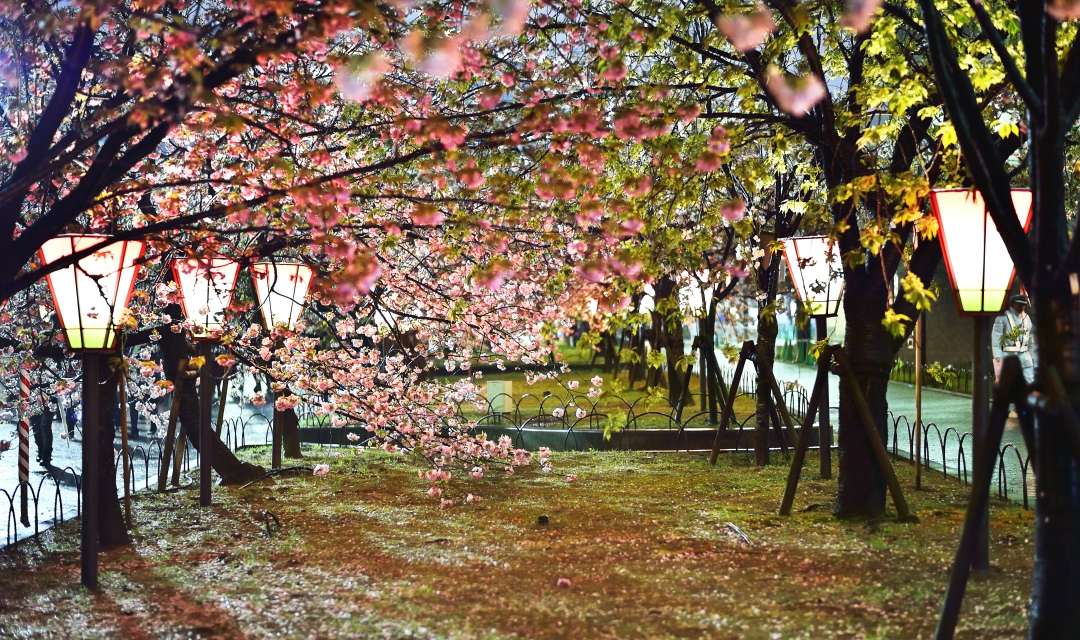Fleeting and fragile, the cherry blossom is one of the unmistakable motifs of Japan. The blooming of these delicate pink flowers each spring is cause for the usually reserved Japanese to really let their hair down.

Nakameguro is one of Tokyo's most popular hanami spots
The anticipation begins to build across the nation as people notice the first indications of the long and chilly winter coming to an end. In the weeks before the pale pink flowers bloom, companies' portable karaoke machines are dusted off, and new recruits are instructed to reserve the best spot for the annual "hanami," cherry blossom viewing revelries. The ritual of hanami traces its roots back to the samurai of the Kamakura Period in the 12th century.
University friends, school groups, neighborhood associations, and families also prepare picnics, drinks, and the ubiquitous blue tarpaulin to lay out beneath the elegant pink flowers.

Cherry blossom is a reminder of the fleeting beauty of life
Personally, with the nation emerging from the coldest months and the trees beginning to bud once more, I always find spring is the best time to be in Japan.
As well as the natural beauty of the season, there is arguably a change in the Japanese people. The average Japanese is typically retiring and shy. However, during the cherry blossom season, that shyness goes out the window, and a passerby is all but certain to receive a mildly inebriated invitation to join a group's revelries.
From personal experience, I'd advise never to pass up one of these opportunities. Don't worry if the language is a barrier; the alcohol and general sense of bonhomie will smooth pretty much every situation.

Forecasting the dates the cherry blossom will open has become something of a science in Japan
Few things are as quintessentially Japanese as cherry blossoms - these flowers are up there with Mt. Fuji and geisha as indisputable symbols of the nation. As such, the progress of the opening of the blooms is followed with near-religious zeal. Newspapers and television news programs carefully chart the northward advance of the arrival of the flowers on maps, with commentators expounding on the significance of the early or late arrival of the blossoms.
As well as the nightly news programs, visitors can track the dates on which the blossoms are due in different cities on the website of the Japan Meteorological Agency, which has raised predicting the blossoms' schedule to an art form.
The first to bloom will be "somei yoshino," a variety of cherry blossom, so pale that it is almost white, followed by the "shidarezakura," and finally, the deeper pink of the "yaezakura."
When the blossoms open in April, several of the biggest parks, shrines, and even graveyards in and around Tokyo—and across the country—are the scene of large-scale over-indulgence that ushers out the winter and welcomes in the new business and school years.

Parks, shrines and even graveyards are the site of hanami gatherings
Ueno Park is a popular spot that gets extremely crowded. Its broad boulevard is lined by cherry trees with low branches that meet overhead, giving the impression that the visitor is walking through a pink tunnel. Do not be surprised to see salarymen asleep and dusted with a light coating of petals.
Outside the capital, the Philosopher's Path in Kyoto links Ginkakuji, better known as the Silver Pavilion, with the Nazenji district, to the north of the ancient capital. The route follows a narrow canal lined by hundreds of cherry trees and smaller temples and shrines. The grounds of the Japan Mint in Osaka are also a favored spot for hanami parties.
And then, when the last flower has gone, Japan goes back to business-as-usual. The public letting down of hair is as brief as the passage of the cherry blossoms themselves.
-
About the author
Julian Ryall first came to Japan in 1992 intending to stay for a year, but quickly realized the advantages of Tokyo over his native London. Nearly three decades later he is the Japan correspondent for The Daily Telegraph and freelances for newspapers and magazines around the world.






















































